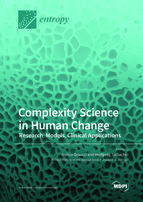Complexity Science in Human Change: Research, Models, Clinical Applications
A special issue of Entropy (ISSN 1099-4300). This special issue belongs to the section "Complexity".
Deadline for manuscript submissions: closed (21 July 2022) | Viewed by 48211
Special Issue Editors
Interests: clinical psychology; psychiatry; complexity science; neuroscience; human interfaces
Special Issue Information
Dear Colleagues,
Self-organization and synchronization are common in human interactions. Empirical research finds that regular patterns of interaction arise in all human relations. The therapist-patient relationship can help to highlight further how interactions evolve and can be changed. Attractors describe stable states of a process, e.g. stability or instability of personality and disorders. They can be detected and described based on empirical time series.
Change is studied in phase transitions when dynamics move between different attractors. This might be evident in behaviors, mental states, and neurobiology. Theoretical models can represent dynamical maps of change in mathematical equations and topological structures. Mapping theory to empirical research, and vice versa, is challenging but heuristic.
Social and clinical sciences are also using qualitative research and models of complexity. They can be metaphorical or well linked to empirical data. The status of qualitative research in Complexity Science can be relevant in relation to quantitative approaches.
One of the main features of complexity and self-organization is the presence of scaling and fractal dynamics with emergence of higher order organizations. Human heterogeneous networks present specific kinds of self-similarity in the embodied mind, individual and social dynamics. Human dynamical systems mapping present rugged landscapes still being explored, including deterministic chaos, stochastic indeterminism, quantum field granularities.
Finally, translational processes and procedures from research to applications and vice versa are particularly relevant as they frequently include interdisciplinary collaborations.
Prof. Dr. Franco Orsucci
Prof. Dr. Wolfgang Tschacher
Guest Editors
Manuscript Submission Information
Manuscripts should be submitted online at www.mdpi.com by registering and logging in to this website. Once you are registered, click here to go to the submission form. Manuscripts can be submitted until the deadline. All submissions that pass pre-check are peer-reviewed. Accepted papers will be published continuously in the journal (as soon as accepted) and will be listed together on the special issue website. Research articles, review articles as well as short communications are invited. For planned papers, a title and short abstract (about 100 words) can be sent to the Editorial Office for announcement on this website.
Submitted manuscripts should not have been published previously, nor be under consideration for publication elsewhere (except conference proceedings papers). All manuscripts are thoroughly refereed through a single-blind peer-review process. A guide for authors and other relevant information for submission of manuscripts is available on the Instructions for Authors page. Entropy is an international peer-reviewed open access monthly journal published by MDPI.
Please visit the Instructions for Authors page before submitting a manuscript. The Article Processing Charge (APC) for publication in this open access journal is 2600 CHF (Swiss Francs). Submitted papers should be well formatted and use good English. Authors may use MDPI's English editing service prior to publication or during author revisions.








